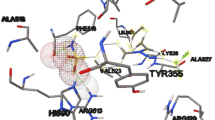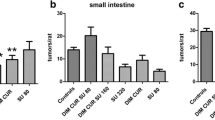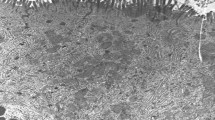Abstract
Cancer research illustrated that combinatorial studies can provide significant improvement in safety and effectiveness over the monotherapy regimens. A combination of two drugs may restrain precancerous colon polyps, opening a new possible opportunity for chemoprevention of colon cancer. In this context, chemopreventive efficacy of a combination regimen of C-phycocyanin, a biliprotein present in Spirulina platensis, a cyanobacterium, which is a selective cycloxygenase-2 (COX-2) inhibitor and piroxicam, a traditional non-steroidal anti-inflammatory drug was considered in 1,2 dimethylhyadrazine (DMH)-induced colon carcinogenesis in rats. Western blotting, immunohistochemistry, DNA fragmentation, fluorescent staining, PGE2 enzyme immunoassay, and carrageenan-induced paw edema test were performed along with morphological and histological analysis. DMH treatment showed a rich presence of preneoplastic lesions such as multiple plaque lesions, aberrant crypt foci, and well-characterized dysplasia. These features were reduced with piroxicam and C-phycocyanin administration. The number of apoptotic cells was featured prominently in all the groups compared with DMH. DMH treatment revealed intact high molecular weight genomic DNA with no signs of laddering/DNA fragmentation while it was noticeable significantly in control and DMH + piroxicam + C-phycocyanin. DMH group showed highest COX-2 expression and PGE2 level in comparison with other groups. Doses of piroxicam and C-phycocyanin used in the present study were established at an anti-inflammatory range. A combination regimen of piroxicam and C-phycocyanin, rather than individually has the much greater potential for reduction of DMH-induced colon cancer development and COX-2 being the prime possible target in such chemoprevention.







Similar content being viewed by others
References
Tammali R, Ramana KV, Singhal SS, Awasthi S, Srivastava SK (2006) Aldose reductase regulates growth factor-induced cyclooxygenase-2 expression and prostaglandin E2 production in human colon cancer cells. Cancer Res 66:9705–9713. doi:10.1158/0008-5472.CAN-06-2105
Sarkar FH, Adsule S, Li Y, Padhye S (2007) Back to future: COX-2 inhibitors for chemoprevention and cancer therapy. Mini Rev Med Chem 7:599–608
Saini MK, Sharma P, Kaur J, Sanyal SN (2008) The cycloxygenase-2 inhibitor etoricoxib is a potent chemopreventive agent of colon carcinogenesis in rat model. J Environ Pathol Toxicol Oncol 28:39–46
Vaish V, Tanwar L, Kaur J, Sanyal SN (2010) Chemopreventive effects of non-steroidal anti-inflammatory drugs in early neoplasm of experimental colorectal cancer: an apoptosome study. J Gastrointest Cancer. doi:10.1007/s12029-010-9188-2
Hinz B, Brune K (2001) Cycloxygenase-2: 10 years later. J Pharm Exp Ther 33(2):367–375
Doherty GA, Byrne SM, Molloy ES, Malhotra V, Austin S, Kay EW, Murray FE, Fitzgerald DJ (2009) Proneoplastic effects of PGE2 mediated by EP4 receptor in colorectal cancer. BMC Cancer 9(207):1–13. doi:10.1186/1471-2407-9-207
Grosch S, Maier JT, Schiffmann S, Geisslinger G (2006) Cyclooxygenase-2 (COX-2)-independent anticarcinogenic effects of selective COX-2 inhibitors. J Nat Can Inst 98(11):736–747. doi:10.1093/jnci/djj206
Ding H, Han C, Gibson R, Steele V, Ambrosio SMD (2003) Piroxicam selectively inhibits the growth of premalignant and malignant human oral cell lines by limiting their progression through the S phase and reducing the levels of cyclins and AP-1. Int J Cancer 107:830–836. doi:10.1002/ijc.11499
Jacoby RF, Seibert KK, Cole CE, Kelloff G, Lubet RA (2000) The cycloxygenase-2 inhibitor celecoxib is a potent chemopreventive and therapeutic agent in the min mouse model of adenomatous polyposis. Cancer Res 60:5040–5044
Komers R, Anderson S, Epstein M (2001) Renal and cardiovascular effects of selective cyclooxygenase-2 inhibitors. Am J Kidney Dis 38(6):1145–1157. doi:10.1053/ajkd.2001.29203
Kelloff GJ, Boone CW, Crowell JA, Steele VE, Lubert R, Sigman CC (1994) Chemopreventive drug development: perspectives and progress. Cancer Epidemiol Biomarkers Prev 3:85–98
Vadiraja BB, Gaikwad NW, Madyastha KM (1998) Hepatoprotective effect of C-phycocyanin protective for carbon tetrachloride and R-(+)-pulegone mediated hepatotoxicity in rats. Biochem Biophys Res Com 249:428–431. doi:10.1006/bbrc.1998.9149
Remirej D, Gonzalez A, Merino N, Gonzalez R, Ancheta O, Romey C, Rodriguez S (1999) Effect of phycocyanin in zymogen-induced arthritis in mice. Phycocyanin as an anti-arthritis compound. Drug Dev Res 48:70–75
Romay C, Armesto J, Remrej D, Gonzalez R, Ieden N, Garces I (1998) Antioxidant and anti-inflammatory properties of C-phycocyanin from blue green algae. Inflamm Res 47:36–41
Romay C, Ledon N, Gongalez R (2000) Effects of phycocyanin extract on prostaglandin E2 levels in mouse ear inflammation test. Arzneim Forsch 50:1106–1109
Dubois RN, Radhika A, Reddy BS, Estingh AJ (1996) Increased cycloxygenase-2 levels in carcinogen induced rat colonic tumors. Gastroenterology 110:1259–1262. doi:10.1053/gast.1996.v110.pm8613017
Bhat VB, Madhyastha KM (2000) C-phycocyanin: a potent peroxyl radical scavenger in vivo and in vitro. Biochem Biophys Res Commun 275:20–25. doi:10.1006/bbrc.2000.3270
Agarwal B, Rao CV, Bhendwal S (1999) Lovastatin augment sulindac-induced apoptosis in colon cancer cells and potentiates the chemopreventive effects of sulindac. Gastroenterology 117:838–847. doi:10.1016/SOO16-5085(99)70342-2
Torrance CJ, Jackson PE, Montgomery E (2000) Combinatorial chemoprevention of intestinal neoplasia. Nat Med 6:1024–1028
Kanwar SS, Vaiphei K, Nehru B, Sanyal SN (2008) Antioxidative effects of non-steroidal anti-inflammatory drugs during the initiation stages of experimental colon carcinogenesis in rats. J Environ Pathol Toxicol Oncol 27(2):89–100
Tanwar L, Vivek V, Sanyal SN (2009) Chemoprevention of 1,2-dimethylhydrazine-induced colon carcinogenesis by a non-steroidal anti-inflammatory drug, etoricoxib, in rats: inhibition of nuclear factor κB. Res Commun 10:1141–1146
Rao CV, Indranie C, Simi B, Manning PT, Connor JR, Reddy BS (2002) Chemopreventive properties of a selective inducible nitric oxide synthase inhibitor. Cancer Res 62:165–170
Bird RP, Good CK (2000) The significance of aberrant crypt foci in understanding the pathogenesis of colon cancer. Toxicol Lett. 112–113:395–402. doi:10.1016/SO378-4274(99)00261-1
Park HS, Goodlad RA, Wright NA (1997) The incidence of aberrant crypt foci and colonic carcinoma in dimethyl hydrazine treated rats varies in site specific manner and depends on tumor histology. Cancer Res 57:4507–4510
Mouille B, Robert V, Blacheir F (2004) Adaptative increase of ornithine production and decrease of ammonia metabolism in rat colonocytes after hyperproteic diet ingestion. J Physiol Gastrointest Liver Physiol 287:G344–G351. doi:10.1152/ajpgi.00445.2003.0193-1857/04
Roediger WE, Truelove SC (1979) Method of preparing isolated colonic epithelial cells (colonocytes) for metabolic studies. Gut 20:484–488
Duke RC, Cohen JJ (1992) Morphological and biochemical assays of apoptosis. Curr Protoc Immunol Suppl 3(17):1–16
Baker AJ, Mooney A, Hughes J, Lombardi D, Johnson RJ, Savill J (1994) Mesangial cell apoptosis: the major mechanism for resolution of glomerular hypercellularity in experimental mesangial proliferative nephritis. J Clin Investig 94:2105–2116
Bradford MM (1976) A rapid and sensitive method for the quantitation of microgram quantities of protein utilizing the principle of protein dye binding. Anal Biochem 72:248–250. doi:10.1016/0300-9629(90)90739-F
Winter CA, Risley EA, Nuss GW (1962) Carrageenan-induced oedema in the hind paw of rat as an assay for anti-inflammatory activity. Proc Soc Exp Biol Ther 111:544–547
Samud AW, Asmawi MZ, Sharma JN, Yusof AP (1999) Anti-inflammatory activity of Crinum asiaticum plant and its effect on bradykinin-induced contractions on isolated uterus. Immunopharmacology 43:311–316
Melen-Mucha G, Niewiadowska H (2002) Frequency of proliferation, apoptosis and their ratio during rat colon carcinogenesis and their characteristic pattern in the dimethylhydrazine-induced colon adenoma and carcinoma. Cancer Invest 20:700–712
Nath R, Scott M, Nadimpalli R, Gupta R, Wang KKW (2000) Activation of apoptosis-linked caspases(s) in NMDA-injured brains in neonatal rats. Neurochem Int 36:119–126. doi:10.1016/SO197-0186(99)00112-6
Wyllie A (1980) Glucocorticoid-induced thymocyte apoptosis is associated with endogenous endonuclease activation. Nature 284:555–556
Buadonpri W, Wichitnithad W, Rojsitthisak P, Towiwat P (2009) Synthetic curcumin inhibits carrageenan-induced paw edema in rats. J Health Res 23(1):11–16
Reddy BS, Nayini J, Tokumo J, Rigotty J, Zang E, Kelloff G (1990) Chemoprevention of colon carcinogenesis by concurrent administration of piroxicam, a non-steroidal anti-inflammatory drug with DL-α difluoromethylornithine, an ornithine decarboxylase inhibitor in diet. Cancer Res 50:2562–2568
Rao CV, Tokumo K, Rigotty J, Zang E, Kelloff G, Reddy BS (1991) Chemoprevention of colon carcinogenesis by dietary administration of piroxicam, α difluoromethylornithine, 16 α-fluoro-5-androsten-17-one and ellagic acid singly and alone. Cancer Res 51:4528–4534
Pretlow TP, Riordan MA, Pretlow TG, Stellato TA (1992) Aberrant crypts in human colonic mucosa: putative preneoplastic lesions. J Cell Biochem 16G:55–62
Tayakama T, Katsuki S, Takahashi Y (1998) Aberrant crypt foci of the colon as precursors of adenoma and cancer. N Engl J Med 339:1277–1284
Pereira MA, Barnes LH, Rassman VL, Kelloff GV, Steele VE (1994) Use of azoxymethane-induced foci of aberrant crypts in rat colon to identify potential cancer chemopreventive agents. Carcinogenesis 15:1049–1054. doi:10.1093/carcin/15.5.1049
Corpet DE, Tache S (2002) Most effective colon cancer chemopreventive agents in rats: a review of aberrant crypt foci and tumor data, ranked by potency. Nutr Cancer 43:1–21
Pollard M, Luckert PH (1984) Effect of piroxicam on primary intestinal tumors induced in rats by N-methylnitrosourea. Cancer Lett 25:117–121
Earnest DL, Alberts DS, Hixon LJ (1997) Piroxicam and other cyclooxygenase inhibitors: potential for cancer chemoprevention. J Cell Biochem 161:156–166
Sheng H, Shao J, Morrow JD, Beauchamp RD, Dubois RN (1998) Modulation of apoptosis and BCl-2 expression by prostaglandin E2 in human colon cancer cells. Cancer Res 58:362–366
Hold GL, El-Omar EM (2008) Genetic aspects of inflammation and cancer. Biochem J 410:225–235. doi:10.1042/BJ20071341
Sobolewski C, Cerella C, Dicato M, Ghibelli L, Diederich M (2010) The Role of Cyclooxygenase-2 in cell proliferation and cell death in human malignancies. Int J Cell Biol 1-21. doi: 10.1155/2010/215158
Srinivasan BD, Kulkarni PS (1989) Inhibitors of the arachidonic acid cascade in the management of ocular inflammation. Prog Clin Biol Res 312:229–249
Accioly MT, Pacheco P, Maya-Monteiro CM, Carrossini N, Robbs BK, Oliveira SS, Kaufmann C, Morgado-Diaz JA, Bozza PT, Viola JP (2008) Lipid bodies are reservoir of cycloxygenase-2 and sites of prostaglandin E2 synthesis in colon cancer cells. Cancer Res 68(6):1732–1740
Chandrashekaran NV, Simmons DL (2004) The cyclooxygenases. Genome Biol 5(9):241.1–241.7. doi:10.1186/qb-2004-5-9-241
Gavrieli Y, Sherman Y, Ben-Sasson SA (1992) Identification of programmed cell in situ via specific labeling of nuclear DNA fragmentation. J Cell Biol 119:493–501. doi:10.1083/jcb.119.3.493
Pardhasaradthi P, Khar A (2003) Phycocyanin mediated apoptosis in AK-5 tumor cells involves down regulation of Bcl-2 and generation of ROS. Mol Cancer Ther 2:1165–1170
Acknowledgment
Financial assistance for this study was received from the Department of Science and Technology, Government. of India [Reference No. (SR/SO/BB-05/2008)]. The support is gratefully acknowledged.
Author information
Authors and Affiliations
Corresponding author
Rights and permissions
About this article
Cite this article
Saini, M.K., Vaiphei, K. & Sanyal, S.N. Chemoprevention of DMH-induced rat colon carcinoma initiation by combination administration of piroxicam and C-phycocyanin. Mol Cell Biochem 361, 217–228 (2012). https://doi.org/10.1007/s11010-011-1106-9
Received:
Accepted:
Published:
Issue Date:
DOI: https://doi.org/10.1007/s11010-011-1106-9




